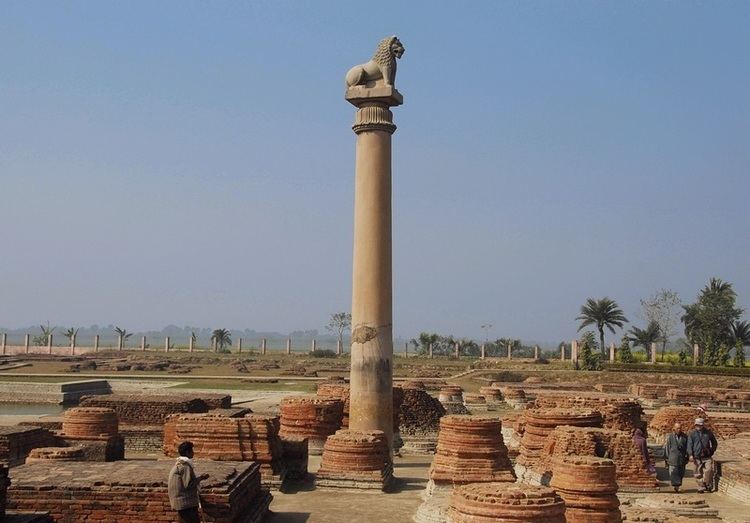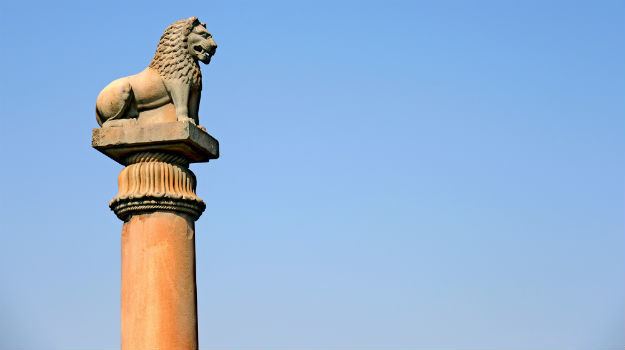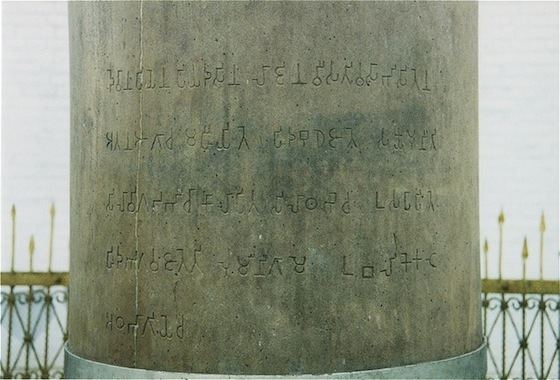 | ||
Similar Stambha, Iron pillar of Delhi, Dhar iron pillar | ||
Ashokanusavaree pillars of ashoka artist by thongchai srisukprasert thai contemporary art
The pillars of Ashoka are a series of columns dispersed throughout the Indian subcontinent, erected or at least inscribed with edicts by the Mauryan king Ashoka during his reign in the 3rd century BC. Originally, there must have been many pillars but only nineteen survive with inscriptions, and only six with animal capitals, which were a target for Muslim iconoclasm. Many are preserved in a fragmentary State. Averaging between 12 to 15 m (40 to 50 ft) in height, and weighing up to 50 tons each, the pillars were dragged, sometimes hundreds of miles, to where they were erected. A few such Ashokan pillars have been discovered in China.
Contents
- Ashokanusavaree pillars of ashoka artist by thongchai srisukprasert thai contemporary art
- Overview
- List of pillars
- The capitals
- Minor Pillar Inscriptions
- Pillars retaining their animals
- Pillar at Allahabad
- Pillars at Lauriya Areraj and Lauriya Nandangarh
- Erecting the Pillars
- Languages and script
- Rediscoveries
- Background of construction
- Alternative theories
- References
Overview
All the pillars were built at Buddhist monasteries, many important sites from the life of the Buddha and places of pilgrimage. Some of the columns carry inscriptions addressed to the monks and nuns. Some were erected to commemorate visits by Ashoka. The traditional idea that all were originally quarried at Chunar, just south of Varanasi and taken to their sites, before or after carving, "can no longer be confidently asserted", and instead it seems that the columns were carved in two types of stone. Some were of the spotted red and white sandstone from the region of Mathura, the others of buff-colored fine grained hard sandstone usually with small black spots quarried in the Chunar near Varanasi. The uniformity of style in the pillar capitals suggests that they were all sculpted by craftsmen from the same region. It would therefore seem that stone was transported from Mathura and Chunar to the various sites where the pillars have been found, and there was cut and carved by craftsmen.

The pillars have four component parts in two pieces: the three sections of the capitals are made in a single piece, often of a different stone to that of the monolithic shaft to which they are attached by a large metal dowel. The shafts are always plain and smooth, circular in cross-section, slightly tapering upwards and always chiselled out of a single piece of stone. The lower parts of the capitals have the shape and appearance of a gently arched bell formed of lotus petals. The abaci are of two types: square and plain and circular and decorated and these are of different proportions. The crowning animals are masterpieces of Mauryan art, shown either seated or standing, always in the round and chiselled as a single piece with the abaci. Presumably all or most of the other columns that now lack them once had capitals and animals.

The six surviving animal sculptures from Ashoka pillars form "the first important group of Indian stone sculpture", though it is thought they derive from an existing tradition of wooden columns topped by animal sculptures in copper, none of which have survived. It is also possible that some of the stone pillars predate Ashoka's reign. There has been much discussion of the extent of influence from Achaemenid Persia, where the column capitals supporting the roofs at Persepolis have similarities, and the "rather cold, hieratic style" of the Sarnath Lion Capital of Ashoka especially shows "obvious Achaemenid and Sargonid influence".

Five of the pillars of Ashoka, two at Rampurva, one each at Vaishali, Lauriya-Araraj and Lauria Nandangarh possibly marked the course of the ancient Royal highway from Pataliputra to the Nepal valley. Several pillars were relocated by later Mughal Empire rulers, the animal capitals being removed.
List of pillars

The two Chinese medieval pilgrim accounts record sightings of several columns that have now vanished: Faxian records six and Xuanzang fifteen, of which only five at most can be identified with surviving pillars. The main survivals, listed with any crowning animal sculptures and the edicts inscribed, are as follows:
The capitals
There are altogether seven remaining complete capitals, five with lions, one with an elephant and one with a zebu bull. One of them, the four lions of Sarnath, has become the State Emblem of India. The animal capitals are composed of a lotiform base, with an abacus decorated with floral, symbolic or animal designs, topped by the realistic depiction of an animal, thought to each represent a traditional directions in India.
Various foreign influences have been described in the design of these capitals. The animal on top of a lotiform capital reminds of Achaemenid column shapes. The abacus also often seems to display a strong influence of Greek art: in the case of the Rampurva bull or the Sankassa elephant, it is composed of honeysuckles alternated with stylized palmettes and small rosettes. A similar kind of design can be seen in the frieze of the lost capital of the Allahabad pillar. These designs likely originated in Greek and Near-Eastern arts. They would probably have come from the neighboring Seleucid Empire, and specifically from a Hellenistic city such as Ai-Khanoum, located at the doorstep of India.
Minor Pillar Inscriptions
These contain inscriptions recording their dedication.
Pillars retaining their animals
The most celebrated capital (the four-lion one at Sarnath (Uttar Pradesh)) erected by Emperor Ashoka circa 250 BC. also called the "Ashoka Column" . Four lions are seated back to back. At present the Column remains in the same place whereas the Lion Capital is at the Sarnath Museum. This Lion Capital of Ashoka from Sarnath has been adopted as the National Emblem of India and the wheel "Ashoka Chakra" from its base was placed onto the centre of the flag of India.
The lions probably originally supported a Dharma Chakra wheel with 24 spokes, such as is preserved in the 13th century replica erected at Wat Umong near Chiang Mai, Thailand by Thai king Mangrai.
The pillar at Sanchi also has a similar but damaged four-lion capital. There are two pillars at Rampurva, one with a bull and the other with a lion as crowning animals. Sankissa has only a damaged elephant capital, which is mainly unpolished, though the abacus is at least partly so. No pillar shaft has been found, and perhaps this was never erected at the site.
The Vaishali pillar has a single lion capital. The location of this pillar is contiguous to the site where a Buddhist monastery and a sacred coronation tank stood. Excavations are still underway and several stupas suggesting a far flung campus for the monastery have been discovered. The lion faces north, the direction Buddha took on his last voyage. Identification of the site for excavation in 1969 was aided by the fact that this pillar still jutted out of the soil. More such pillars exist in this greater area but they are all devoid of the capital.
Pillar at Allahabad
In Allahabad there is a pillar with inscriptions from Ashoka and later inscriptions attributed to Samudragupta and Jehangir. It is clear from the inscription that the pillar was first erected at Kaushambi, an ancient town some 30 kilometres west of Allahabad that was the capital of the Koshala kingdom, and moved to Allahabad, presumably under Muslim rule. The pillar is now located inside the Allahabad Fort, also the royal palace, built during the 16th century by Akbar at the confluence of the Ganges and Yamuna rivers. As the fort is occupied by the Indian Army it is essentially closed to the public and special permission is required to see the pillar. The Ashokan inscription is in Brahmi and is dated around 232 BC. A later inscription attributed to the second king of the Gupta empire, Samudragupta, is in the more refined Gupta script, a later version of Brahmi, and is dated to around 375 AD. This inscription lists the extent of the empire that Samudragupta built during his long reign. He had already been king for forty years at that time and would rule for another five. A still later inscription in Persian is from the Mughal emperor Jahangir. The Akbar Fort also houses the Akshay Vat, an Indian fig tree of great antiquity. The Ramayana refers to this tree under which Lord Rama is supposed to have prayed while on exile.
Pillars at Lauriya-Areraj and Lauriya-Nandangarh
The column at Lauriya-Nandangarh, 23 km from Bettiah in West Champaran district, Bihar has single lion capital. The hump and the hind legs of the lion project beyond the abacus. The pillar at Lauriya-Areraj in East Champaran district, Bihar is presently devoid of any capital.
Erecting the Pillars
The Pillars of Ashoka may have been erected using the same methods that were used to erect the ancient obelisks. Roger Hopkins and Mark Lehrner conducted several obelisk erecting experiments including a successful attempt to erect a 25ton obelisk in 1999. This followed two experiments to erect smaller obelisks and two failed attempts to erect a 25-ton obelisk.
Languages and script
Alexander Cunningham, one of the first to study the inscriptions on the pillars, remarks that they are written in eastern, middle and western Prakrits which he calls "the Punjabi or north-western dialect, the Ujjeni or middle dialect, and the Magadhi or eastern dialect." They are written in the Brahmi script.
Rediscoveries
A number of the pillars were thrown down by either natural causes or iconoclasts, and gradually rediscovered. One was noticed in the 16th century by the English traveller Thomas Coryat in the ruins of Old Delhi. Initially he assumed that from the way it glowed that it was made of brass, but on closer examination he realized it was made of highly polished sandstone with upright script that resembled a form of Greek. In the 1830s James Prinsep began to decipher them with the help of Captain Edward Smith and George Turnour. They determined that the script referred to King Piyadasi which was also the epithet of an Indian ruler known as Ashoka who came to the throne 218 years after Buddha's enlightenment. Scholars have since found 150 of Ashoka's inscriptions, carved into the face of rocks or on stone pillars marking out a domain that stretched across northern India and south below the central plateau of the Deccan. These pillars were placed in strategic sites near border cities and trade routes.
The Sanchi pillar was found in 1851 in excavations led by Sir Alexander Cunningham, first head of the Archaeological Survey of India. There were no surviving traces above ground of the Sarnath pillar, mentioned in the accounts of medieval Chinese pilgrims, when the Indian Civil Service engineer F.O. Oertel, with no real experience in archaeology, was allowed to excavate there in the winter of 1904-05. He first uncovered the remains of a Gupta shrine west of the main stupa, overlying an Ashokan structure. To the west of that he found the lowest section of the pillar, upright but broken off near ground level. Most of the rest of the pillar was found in three sections nearby, and then, since the Sanchi capital had been excavated in 1851, the search for an equivalent was continued, and the Lion Capital of Ashoka, the most famous of the group, was found close by. It was both finer in execution and in much better condition than that at Sanchi. The pillar appeared to have been deliberately destroyed at some point. The finds were recognised as so important that the first onsite museum in India (and one of the few then in the world) was set up to house them.
Background of construction
Ashoka ascended to the throne in 269 BC inheriting the empire founded by his grandfather Chandragupta Maurya. Ashoka was reputedly a tyrant at the outset of his reign. Eight years after his accession he campaigned in Kalinga where in his own words, "a hundred and fifty thousand people were deported, a hundred thousand were killed and as many as that perished..." After this event Ashoka converted to Buddhism in remorse for the loss of life. Buddhism didn't become a state religion but with Ashoka's support it spread rapidly. The inscriptions on the pillars described edicts about morality based on Buddhist tenets. Legend has it that Ashoka built 84,000 Stupas commemorating the events and relics of Buddha's life. Some of these Stupas contained networks of walls containing the hub, spokes and rim of a wheel, while others contained interior walls in a swastika (卐) shape. The wheel represents the sun, time, and Buddhist law (the wheel of law, or dharmachakra), while the swastika stands for the cosmic dance around a fixed center and guards against evil.
Alternative theories
Ranajit Pal suggests that the pillar, now at Feroz Shah Kotla, Delhi, which was brought from Topra in Ambala was one of the lost altars of Alexander.
